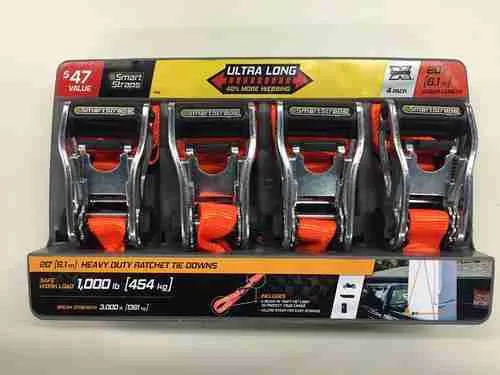How to release a ratchet strap

A ratchet strap is a fastener used to keep in place consignment or appliances during conveyance. Ratchet straps are used oftentimes to secure heavyweight cargo. Ratchet straps are convenient, but care has to be taken because they can also be delicate to use. Immediately you get familiar with the workings of a ratchet strap, you will not want to use any other thing. They have in-built pressure gadgets and have estimated weight dimensions that make them a dependable and secure tie-down choice. As common as they are, for some people, ratchet straps can be overwhelming to use and may have parts that you are not familiar with. These straps can get jammed if not carefully handled or if you do not use them correctly. Ratchet straps are quite useful but it can be a very frustrating experience when it gets jammed. All ratchet straps work the same way using a ratchet mechanism but first, we need to understand the workings of a ratchet strap.
NOTE: It is pertinent to examine any ratchet strap before use. Examine the webbing and ratchet handle construction to ensure they are not mutilated. Red flags that indicate a ratchet strap should not be used are:
- Worn out webbing
- Mold and any form of damage.
- If the ratchet needs oiling, flit WD-40 on it and be careful not to get it on the webbing.
A regular ratchet appliance makes use of a gear and a single pawl. A ratchet strap uses:
a gear, a manual pawl (hand-operated), an automatic pawl (mechanical)
When you secure a ratchet strap, one of the pawls is hooked into the gearwheel. When you set to lose a ratchet strap, neither pawl is hooked. Therefore, when a ratchet strap is jammed, you just have not unhooked the pawls. It is important that you’re knowledgeable about the ratchet strap settings to reduce jamming to the barest minimum.
Notable Ratchet Strap Settings
Ratchet straps are commonly used in any one of the following settings below:
- Ratcheting setting – You can secure it.
- Loosening setting – The ratchet is extended till the auto pawl rests on the cam; hence to release it, you mount pressure on the manual pawl then pull the strap.
- Locked setting – When it is firm, shut the ratchet totally and ensure the auto and manual pawls are hooked; this will ensure it stays locked.
A usual ratchet strap challenge is getting it to release with ease. Ordinarily, the pressure applied to the manual pawl bar will do the magic and keep making the ratchet flatter.
So now, let us journey together as we look at how a ratchet strap could get jammed and also how to release it.
- Corroded Ratchet
Forgetting to keep your straps and it being left inside your trailer will cause corrosion to happen faster, and when this happens, the ratchet’s pawls get sticky, and it is then difficult to secure or set loose the ratchet strap. This challenge can be solved in two ways; applying the method that provides a solution to all corrosion challenges; flitting some WD-40 on the pawls, then shake the hold as you compress the manual pawl to release the ratchet, ensure continuous flitting of WD-40 as required. It is important to note that the release might not be immediate to get the ratchet working appropriately again.
- Partially Unclasped Ratchet
This oftentimes is the problem when a ratchet is jammed. The ratchet is partly closed. So, to release the strap from the ratchet, you must ensure you apply pressure on the manual pawl. This will cause the manual pawl to rise and create space for the ratchet to come flat. This takes a bit of manual power to disengage; you will have to pull hard on the unhooked strap so that you can get the strap to finally uncoil from the spool. Take note that before releasing your hold on the manual pawl, lift the major hold upwards. Keep pulling upwards till the ratchet appliance is as flat as it can be, then pull the loose strapping out of the ratchet. If this does not work the first time, keep repeating the process until it works.
- Ratchet’s Spindle is jam-packed
This eventuality is also commonplace. It is quite easy to encounter this challenge if you do not detach the slack before securing your consignment. Taking out the slack stops the spindle from building up; if you strap down your appliance correctly, you will observe that you have a leftover strap. This is the way it is supposed to be! It is better to keep little strap actually wrapping the spindle; this is to ensure that the pawls function correctly. It is important to note that a jam-packed spindle is very hazardous, this makes it tougher to secure and lock, and might likely thrust on the automatic pawl.
If your Ratchet contraption does not work after the aforementioned, you might need to consider getting a new set of Ratchet Straps.
How to store your ratchet strap
To avoid all the difficulties mentioned above, the way you keep the ratchet strap matters and also determines how long it will be used.
So to store it, put into consideration the use of a rubber band to keep it neatly folded or rolled into ratchet straps and webbing together. Besides, you can put them in a bag and keep them in a dry place away from heat and the sun. Make sure that you never keep them anywhere that’s moist because it will cause molds to grow on the ratchet strap and also cause corrosion of the metal parts; also keeping them away from fluorescent light makes the nylon and elastic thread frail, causing them to fade out, deteriorate, and possibly will no longer be durable.














No Comment